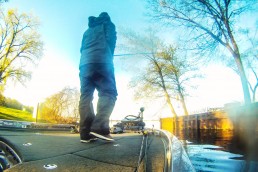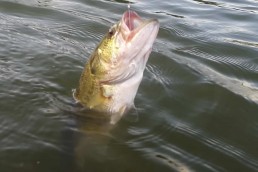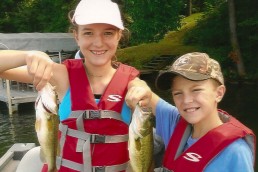Fishing Seawalls for Summer Bass
SHARE THIS POST
From his indoctrination into bass fishing, a bass angler knows that bass love boat docks. But because of their location, seawalls that are located behind or in-between docks are often overlooked. This may be because the seawall isn’t seen a first glance, or because the seawall isn’t accessible to make an easy cast.
Waterfront property owners, to help prevent their shorelines from eroding, place seawalls—but for bass, these concrete or metal vertical structures offer a great ambush point. From there, they can corner bait up against the hard structure. Because these man-made structures will accumulate algae growth on them, baitfish will also be attached, along with smaller fish feeding on them, so these seawalls act as a food creation device for bass.
To an angler’s eye, the above-the-water sections of seawalls will likely all look very similar. But understanding what is below the waterline along these seawalls is key, as that will aid in establishing a possible pattern.
You first want to look for any irregularities on the seawall itself, such as a corner or section that has blown or bowed out some, as it creates a point for a bass to easily sit behind. This also applies to holes or indentations in the seawall; bass will back up into these holes so they can grab an easy meal as they emerge from the shadows.
Another visible characteristic to look for is a drainage line running from the owner’s property into the lake. This will do several things for that given seawall: one, it will introduce current to that area; two, it will possibly wash into gravel or sand, creating a hard bottom area next to the seawall; and third, it will create a hole from which the stream of water will wash out a deeper section of the lake bottom.
Many times, these small subtle changes will dictate where bass sit along that seawall. There are other not-so-obvious traits that make one given seawall better than another, too, such as a lake or river having a channel swing that runs into said seawall. This channel serves as a “highway” for bass to swim along.
Are you enjoying this post?
You can be among the first to get the latest info on where to go, what to use and how to use it!
As you identify a key seawall, you’ll want to make a mental note as to whether there is shade present. Overhanging trees or canopies from adjacent boat docks will cast their shade onto a given seawall at different times during the day, which often incites bass along the seawall to become more active and feed.
Fishing seawalls, feel free to use any presentation that you might use fishing a boat dock. For me, a jig is hard to beat, as you can flip or pitch it to key points, holes or transition areas; you can also cast it out and work it parallel along the face of the seawall itself. An All-Terrain Tackle AT Jig (1/2-ounce) with a Zoom Super Chunk as the trailer is my go-to, as I can cover water quickly and keep contact with the bottom to hit those hard bottom areas. Being that these areas have metal or concrete, along with possibly some rock or wood, using a Fluorocarbon line is advised as it’s very abrasion resistant, yet sensitive, with low line-stretch. My top choice? Seaguar AbrazX in 20-pound test.
During the lowlight hours of the day (or in the aforementioned shade), in which the bass are actively feeding along a seawall, fishing a buzzbait is a great way to cover water and look for stretches on which you’ll want to slow down with the jig. My favorite way to use a buzzbait is as a search lure that determines where the bass are positioned on the cover I’m fishing. Making parallel casts to the cover will keep your bait in the strike zone longer and increase the number of strikes you’ll get. You want to make sure your buzzbait runs into the seawall and makes contact with the concreate or metal on your retrieve, as this erratic action will often trigger a strike.
In deciding which weight buzzbait to use, you have to consider the activity level of the bass, the necessary length of your cast, and what species the bass are feeding on. If the bass are zoning in on smaller baitfish or insects, I would use a ¼ ounce bait—as opposed to a 1/2-ounce bait used to make long casts. Most of the time, I’lluse a 3/8-ounce buzzbait in white or black, or the War Eagle Buzz Toad in Grey Ghost. Since I may be casting my buzzbait over boat dock cables, I like to spool up with braided grey line in in 40-pound test, so I can get that fish hoisted over or around dock posts or cables.
This summer, as you’re cruising along and fishing boat docks, be sure to look beyond that eye catching cover, and see if there’s a seawall behind it.
MWO
SHARE THIS POST
Did you enjoy this post?
You can be among the first to get the latest info on where to go, what to use and how to use it!
Glenn Walker
Glenn Walker has been fishing Minnesota and Mississippi River tournaments for more than 15 years, spreading his passion and knowledge of the sport via articles and videos. For more information, check out glennwalkerfishing.com or on Facebook @GlennWalkerFishing.



